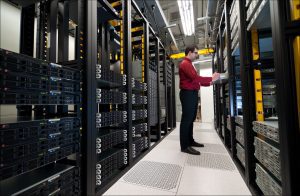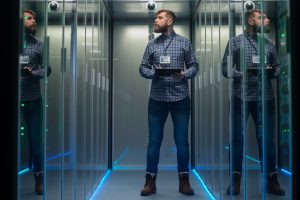With December upon us, the floodgates are officially open for blog posts that look back at the year we leave behind or towards the year ahead. Consider this one something of a combo, as we look at some of the blog post topics that most resonated in 2016 and that we expect will have staying power in 2017.
Edge data centers and the IOT
Blog posts that covered edge data centers in some way, shape or form tended to do well in 2016, often in connection with the Internet of Things. That makes perfect sense because the IOT is creating demand for edge data centers. They act as aggregation points for data being funneled from sensors and other “things” to a centralized data center where it becomes “big data,” ready to be mined and analyzed.
One of the most popular blog posts of 2016 – Kevin Brown’s “IoT, Edge Computing, Big Data – Creating the Next Wave in Data Center Innovation” – touched on all of these ideas, while neatly outlining the how the effective use of big data promises to vastly improve management of data centers of all types, including edge. If Brown’s post is any indicator, that’s a topic you can expect to hear lots more about in 2017.
Other bloggers homed in on specific examples of where edge data centers come into play, such as in retail shopping and the Pokémon GO craze. (Is that still a thing?) Here again, I expect we’ll see lots more examples in the year ahead.
A couple of additional posts delved deeper into edge issues. One discussed how edge computing can combat latency issues that crop up with cloud computing and bandwidth-intensive applications such video, while a related covered how edge computing can improve performance and reliability for cloud applications – both important issues as we move further into the cloud era.
Open Compute Project
Part of the allure of edge data centers is the energy efficiency that comes with putting lots of compute power in a relatively small space. The Open Compute Project was born out of companies such as Facebook that were interested in a similar issue – getting more, less expensive compute power out of massive data centers.
While the OCP dealt mainly with servers and power supplies (at least to start), Schneider Electric was among the first to discuss how best to support an OCP architecture from a power perspective. A post by Wendy Torell walked through various options in data center power designs, detailing the level of redundancy each provides and the level of cost savings. She knows the topic well, having co-authored a white paper along with Kevin Brown on the topic, “Analysis of Data Center Architectures Supporting Open Compute Project (OCP).”
Of course, most companies are not likely to adopt an all-OCP architecture in the immediate future, which means OCP infrastructure will have to co-exist with traditional architectures for some time. Brown tackled that topic in a talk at the Open Compute Summit in early 2016, as outlined in this post.
Lithium-ion batteries
The Schneider Electric vision for an OCP power architecture also takes into account another forward-looking development: lithium-ion (Li-ion) batteries.
In another of the most-popular posts of 2016, Patrick Brouhon discussed how Li-ion batteries are poised to bring big changes to data center UPSs. They take up far less space than existing generations of valve-regulated lead-acid (VRLA) batteries and can withstand higher temperatures. As the post details, Li-ion batteries also last twice as long, require less maintenance and offer better management capabilities as compared to VRLA batteries.
Here’s what that may mean in practice, Brouhon writes:
A cabinet that today supports about 60 kVA with 10 min. of energy storage with VRLA batteries, may one day protect 150-200 kVA with that same 10 min. of storage using Li-ion batteries, effectively more than doubling its power density. With this paradigm shift, it is also not difficult to imagine more power protection integrated right into IT racks, because it will take up far less space and require dramatically less frequent maintenance.
Beyond UPSs, Li-ion batteries may also come into play for long-term energy storage in data centers, which can help companies reduce the sometimes exorbitant demand charge fees they pay to utilities. Demand charges are basically fees that companies pay for using larger than normal amounts of electricity, even if only for a short time. As this post by Barthold Veenendaal details, with the appropriate surrounding infrastructure, Li-ion batteries may provide an alternative to meet those short-term energy needs.
Data center planning
With all this change underway, it’s little wonder that posts having to do with data center planning also did well in 2016.
This post by Steve Carlini highlights the importance of detailed but practical data center design, and points readers to a guide that offers just that.
The guide lays out a simple, four-step plan for proper data center design planning. Although, as I wrote in this September blog post, some of the steps at first blush may seem complicated, particularly number 2, which says, “Develop a system concept.”
But as my post explains, that’s where Schneider Electric reference designs come in. The company offers more than 40 reference designs in its data center reference design library. Most are highly customizable, enabling you to use them as a solid jumping off point to your own project.
I expect data center design topics will be just as popular in 2017 as planners try to keep up with all the latest developments. We’ll be here to do our part to chronicle them and help you along the way. In fact, if there are any data center topics you’d like to see covered in 2017, just let us know in the comments below.




Conversation
The year 2016 was phenomenal for data management software. The evolution of technology, higher penetration of smartphones and increased competition have worked in favor of data centers. You mentioned the example of Pokemon Go. While the craze seems to have eased significantly, it has certainly opened the door for more innovative ideas. There would likely be several attempts like that in 2017.